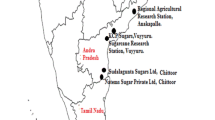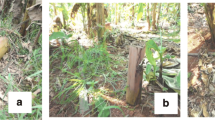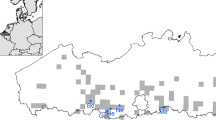Abstract
Cacao mirids (Sahlbergella singularis, Distantiella theobroma and Bryocoropsis laticollis) were captured in pheromone traps releasing a 2:1 blend of the sex pheromone components of the two first named species in a series of five experiments on cacao (Theobroma cacao) plantations in Ghana. A total of 835 cacao mirids were caught, all male, 95% of which were S. singularis, 3% D. theobroma and 2% B. laticollis. Two sticky trap and two water trap designs made from locally available materials were as effective for capturing S. singularis and total mirids as the best sticky trap from previously reported studies. Coating the outer surface of a large water trap with sticker increased the catch 4.4×, and 2.7× for a cylindrical sticky trap. Sticker on the outside of the water trap also increased the inside catch of S. singularis by 76% and total mirids by 71%. The numbers of S. singularis and D. theobroma trapped increased with increasing trap elevation and were highest around canopy level. Those traps caught an average 12×. more mirids than traps at 1.8 m, the height recommended currently. Therefore, large water traps coated with sticker and aligned with the cacao canopy should raise the current capture rates of pheromone traps for cacao mirids about 50×, which may be sufficient for effective pest management by mass trapping without synthetic insecticides.
Similar content being viewed by others
References
Anikwe J. C. and Makanjuola W. A. (2013) Effectiveness of some ecological pest management practices against the brown cocoa mirid, Sahlbergella singularis (Hemiptera: Miridae) in Nigeria. The Zoologist 11, 1–6.
Ayenor G. K., Van Huis A., Obeng-Ofori D., Padi B. and Röling N. G. (2007) Facilitating the use of alternative capsid control methods towards sustainable production of organic cocoa in Ghana. International Journal of Tropical Insect Science 27, 85–94.
Babin R., Sounigo O., Dibog L. and Nyassé S. (2004) Field tests for antixenosis and tolerance of cocoa towards mirids. INGENIC Newsletter 9, 45–50.
Bhardwajt S. P. and Chander R. (1992) Design and placement of synthetic sex attractant traps for monitoring apple leaf roller, Archips pomivora Meyrick (Lepidoptera: Tortricidae) in North Indian orchards. Tropical Pest Management 38, 61–64.
Bisseleua D. H. B., Yede and Vidal S. (2011) Dispersion models and sampling of cacao mirid bug Sahlbergella singularis (Hemiptera: Miridae) on Theobroma cacao in Southern Cameroon. Environmental Entomology 40, 111–119.
Collingwood C. A. (1977) African mirids, pp. 71–76. In Les Mirides du Cacaoyer (edited by E. M. Lavabre). Maisonneuve and Larose, Paris, France.
Collingwood C. A. and Marchart H. (1971) Chemical control of capsids and other insect pests in cocoa rehabilitation, pp. 89–99. In Proceedings of the 3rd International Cocoa Research Conference. 23–29 November, Accra, Ghana, Cocoa Research Institute, Tafo, Ghana.
Downham M. C. A., Cork A., Farman D., Hall D. R., Innoccenzi R, Phythian S., Padi B., Lowor S. and Sarfo J. E. (2002) Sex pheromone components of the cocoa mirids, Distantiella theobroma (Dist.) and Sahlbergella singularis Hagl. (Heteroptera: Miridae), p. 167. In Abstract Book, 19th Annual Meeting of the International Society of Chemical Ecology. 3–7 August 2002, Hamburg, Germany International Society of Chemical Ecology, Kentucky, USA. Available at: http://www.chemecol.org/programs/2002.pdf.
Entwistle P. F (1972) Pests of Cocoa. Longman Group Ltd, London. 779 pp.
Entwistle P. R, Johnson C. G. and Dunn E. (1959) New pests of cocoa (Theobroma cacao L.) in Ghana following applications of insecticides. Nature 184, 2040–2041.
Gibbs D. G., Pickett A. D. and Leston D. (1968) Seasonal population changes in cocoa capsids (Heteroptera: Miridae) in Ghana. Bulletin of Entomological Research 58, 279–293.
Ishimoto M., Sato H, Muraoka Y, Aoki Y, Takita M., Noguchi R, Fukumoto T., Mochizuki F., Takahashi A. and Higuchi H. (2006) Monitoring adult rice leaf bug, Trigonotylus caelestialium (Kirkaldy) (Heteroptera: Miridae), with a synthetic sex pheromone trap in paddy fields. Japanese Journal of Applied Entomology and Zoology 50, 311–318.
Johnson C. G. (1962) Capsids: A review of current knowledge, pp. 316–331. In Agriculture and Land Use in Ghana (edited by J. B. Wills). Oxford University Press, London, New York.
Lavabre E. M., Decelle J. and Debord F. (1963) Etude de l’evolution regionale et saisonniere des populations des Mirides (Capsides) en Cote d’Ivoire. Café, Cacao, Thé 7, 267–289.
Mahob J. R., Babin R., ten Hoopen G. M., Dibog L., Yede, Hall D. R. and Bilong Bilong C. F. (2011) Field evaluation of synthetic sex pheromone traps for the cocoa mirid Sahlbergella singularis (Hemiptera: Miridae). Pest Management Science 67, 672–676.
Mahrizal L., Nalley L., Dixon B. L. and Popp J. (2012) Necessary price premiums to incentivize Ghanaian organic cocoa production: A phased, orchard management approach. HortScience 47, 1617–1624.
McBrien H. L. and Millar J. G. ( 1999 ) Phytophagous bugs, pp. 277–304. In Pheromones of Non-Lepidopteran Insects Associated with Agricultural Plants (edited by J. Hardie and A. K. Minks). CAB International, Wallingford, UK.
McBrien H. L., Judd G.J.R. and Borden J. H. (1996) Potential for pheromone-based mating disruption of the mullein bug, Campylomma verbasci (Meyer) (Heteroptera: Miridae). The Canadian Entomologist 128, 1057–1064.
Murlis J., Willis MA. and Cardé R. T. (2000) Spatial and temporal structures of pheromone plumes in fields and forests. Physiological Entomology 25, 211–222.
Owusu-Manu E. (1994) Capsid thrust; mirid population. Annual Report of the Cocoa Research Institute of Ghana 1991/92, pp. 138–139.
Owusu-Manu E. (2002) New approach to mirid control on mature cocoa. Ghana Journal of Agricultural Science 35, 111–120.
Padi B., Oduor G. and Hall D. R. (2002) Development of mycoinsecticides and pheromones for cocoa mirids in Ghana. Final Technical Report. 1 October 1998–31 March 2002. 53 pp. Available at: https://assets.publishing.service.gov.uk/media/57a08d38e5274a31e000170c/R7249_FTR.pdf.
Perry J. N, Wall C. and Greenway A. R. (1980) Latin square designs in field experiments involving insect sex attractants. Ecological Entomology 5, 385–396.
Pimentel Gomes F. (1970) 281. Note: An extension of the method of joint analysis of experiments in complete randomised blocks. Biometrics 26, 332–336. doi: 10.2307/2529081.
Sarfo J. E., Padi B., Hall D.H., Downham M. C. and Ackonor J. B. (2007) Effects of cocoa mirid pheromone trap positioning and density on trap catches, pp. 1635–1644. In Proceedings of the 15th International Cocoa Research Conference. 9–14 October 2006, San Jose, Costa Rica, Cocoa Producers Alliance, Lagos Nigeria.
SGER. (2013) State of the Ghana economy report, 2013. The Institute of Statistical Social & Economic Research, University of Ghana, Legon (Accra), Ghana. Available at: https://www.ug.edu.gh/news/isser-launches-2013-state-ghanaian-economy-report (accessed 21 March 2016).
Stapley J. H. and Hammond P. S. (1959) Large scale trials with insecticides against capsids on cocoa in Ghana. Empire Journal of Experimental Agriculture 27, 343–353.
Storberget S. (2014) Catching the European tarnished plant bug Lygus rugulipennis using baited funnel traps. MSc thesis, Norwegian University of Life Sciences. 36 pp. Available at: http://hdl.handle.net/11250/225347 http://hdl.handle.net/11250/225348 (accessed 21 March, 2016).
Thomson D. R., Gut L. J. and Jenkins J.W. (1999) Pheromones for insect control, pp. 385–412. In Methods in Biotechnology, Volume 5: Biopesticides Use and Delivery (edited by F. R. Hall and J. J. Menn). Humana Press, Totowa, New Jersey, USA.
Trematerra P., Fontana F. and Mancini M. (1996) Effects of accumulated dead and alive insects in trap on the capture of Tribolium castaneum (Herbst). Anzeiger für Schädlingskunde, Pflanzenschutz, Umweltschutz 69, 3–9.
Witzgall R, Kirsch P. and Cork A. (2010) Sex pheromones and their impact on pest management. Journal of Chemical Ecology 36, 80–100.
Yasuda T. and Higuchi H. (2012) Sex pheromones of Stenotus rubrovittatus and Trigonotylus caelestialium, two mirid bugs causing pecky rice, and their application to insect monitoring in Japan. Psyche 2012, Article ID 435640.
Yonce C. E., Gentry C. R., Tumlinson J. H., Doolittle R. E. and Nielsen D. G. (1976) Lesser peachtree borer: Influence of trap height, substrates, concentration and trap design on capture of male moths with females and with a synthetic pheromone. Environmental Entomology 5, 417–120. doi: 10.1093/ee/5.3.417.
Author information
Authors and Affiliations
Corresponding author
Rights and permissions
About this article
Cite this article
Sarfo, J.E., Campbell, C.A.M. & Hall, D.R. Design and placement of synthetic sex pheromone traps for cacao mirids in Ghana. Int J Trop Insect Sci 38, 122–131 (2018). https://doi.org/10.1017/S1742758417000340
Accepted:
Published:
Issue Date:
DOI: https://doi.org/10.1017/S1742758417000340




